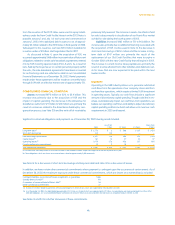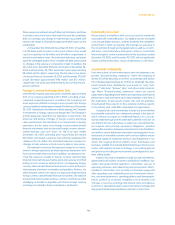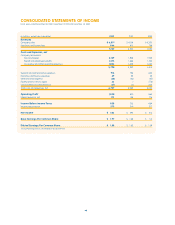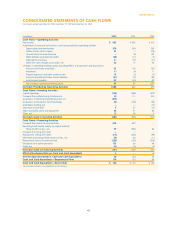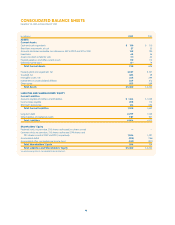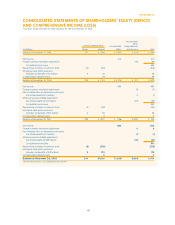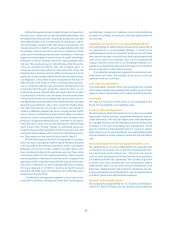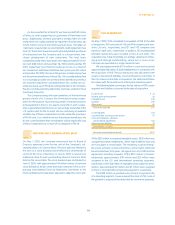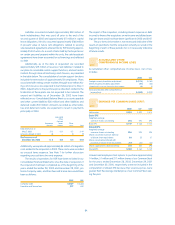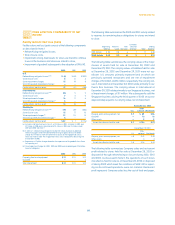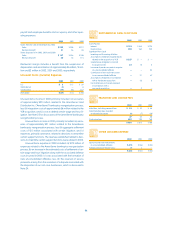Pizza Hut 2002 Annual Report Download - page 51
Download and view the complete annual report
Please find page 51 of the 2002 Pizza Hut annual report below. You can navigate through the pages in the report by either clicking on the pages listed below, or by using the keyword search tool below to find specific information within the annual report.
Reclassifications
We have reclassified certain items in the accompanying Consol-
idated Financial Statements and Notes thereto for prior periods to
be comparable with the classification we adopted for the fiscal
year ended December 28, 2002. These reclassifications had no
effect on previously reported net income.
Franchise and License Operations
We execute franchise or license agreements for each unit which
sets out the terms of our arrangement with the franchisee or
licensee. Our franchise and license agreements typically require
the franchisee or licensee to pay an initial, non-refundable fee and
continuing fees based upon a percentage of sales. Subject to our
approval and payment of a renewal fee, a franchisee may gen-
erally renew the franchise agreement upon its expiration.
We recognize initial fees as revenue when we have per-
formed substantially all initial services required by the franchise
or license agreement, which is generally upon the opening of a
store. We recognize continuing fees as earned with an appropri-
ate provision for estimated uncollectible amounts, which is
included in franchise and license expenses. We recognize
renewal fees in income when a renewal agreement becomes
effective. We include initial fees collected upon the sale of a
restaurant to a franchisee in refranchising gains (losses). Fees for
development rights are capitalized and amortized over the life of
the development agreement.
We incur expenses that benefit both our franchise and license
communities and their representative organizations and our com-
pany operated restaurants. These expenses, along with other
costs of sales and servicing of franchise and license agreements
are charged to general and administrative expenses as incurred.
Certain direct costs of our franchise and license operations are
charged to franchise and license expenses. These costs include
provisions for estimated uncollectible fees, franchise and license
marketing funding, amortization expense for franchise related
intangible assets and certain other direct incremental franchise
and license support costs. Franchise and license expenses also
includes rental income from subleasing restaurants to franchisees
net of the related occupancy costs.
We monitor the financial condition of our franchisees and
licensees and record provisions for estimated losses on receiv-
ables when we believe that our franchisees or licensees are
unable to make their required payments. While we use the best
information available in making our determination, the ultimate
recovery of recorded receivables is also dependent upon future
economic events and other conditions that may be beyond our
control. Included in franchise and license expenses are provisions
for uncollectible franchise and license receivables of $15 million,
$24 million and $30 million in 2002, 2001 and 2000, respectively.
Direct Marketing Costs
We report substantially all of our direct marketing costs in occu-
pancy and other operating expenses. We charge direct marketing
costs to expense ratably in relation to revenues over the year in
which incurred and, in the case of advertising production costs, in
the year first shown. Deferred direct marketing costs, which are
classified as prepaid expenses, consist of media and related
advertising production costs which will generally be used for the
first time in the next fiscal year. To the extent we participate in
advertising cooperatives, we expense our contributions as
incurred. At the end of 2002 and 2001, we had deferred market-
ing costs of $8 million and $2 million, respectively. Our advertising
expenses were $384 million, $328 million and $325 million in
2002, 2001 and 2000, respectively.
Research and Development Expenses
Research and development expenses, which we expense as
incurred, were $23 million in 2002, $23 million in 2001 and $24
million in 2000.
Impairment or Disposal of Long-Lived Assets
Effective December 30, 2001, the Company adopted SFAS No. 144,
“Accounting for the Impairment or Disposal of Long-Lived Assets”
(“SFAS 144”). SFAS 144 retained many of the fundamental provisions
of SFAS No. 121, “Accounting for the Impairment of Long-Lived
Assets and for Long-Lived Assets to Be Disposed Of” (“SFAS 121”),
but resolved certain implementation issues associated with that
Statement. The adoption of SFAS 144 did not have a material
impact on the Company’s consolidated results of operations.
In accordance with SFAS 144, we review our long-lived assets
related to each restaurant to be held and used in the business,
including any allocated intangible assets subject to amortization,
semi-annually for impairment, or whenever events or changes in
circumstances indicate that the carrying amount of a restaurant
may not be recoverable. We evaluate restaurants using a “two-
year history of operating losses” as our primary indicator of
potential impairment. Based on the best information available, we
write down an impaired restaurant to its estimated fair market
value, which becomes its new cost basis. We generally measure
estimated fair market value by discounting estimated future cash
flows. In addition, when we decide to close a restaurant it is
reviewed for impairment and depreciable lives are adjusted. The
impairment evaluation is based on the estimated cash flows from
continuing use through the expected disposal date and the
expected terminal value.
Store closure costs include costs of disposing of the assets as
well as other facility-related expenses from previously closed
stores. These store closure costs are expensed as incurred.
Additionally, at the date the closure is considered probable, we
record a liability for the net present value of any remaining oper-
ating lease obligations subsequent to the expected closure date,
net of estimated sublease income, if any.
49.
Yum! Brands Inc.




